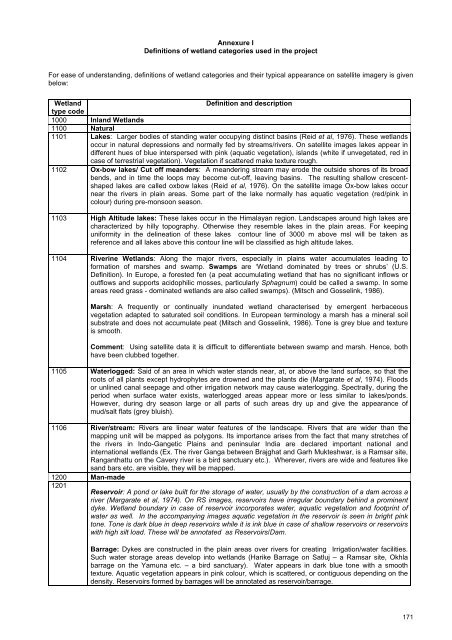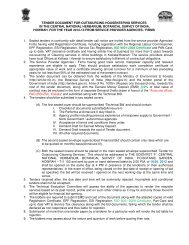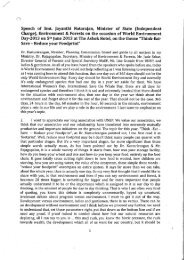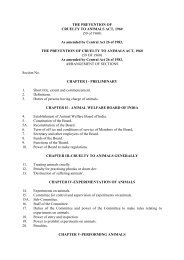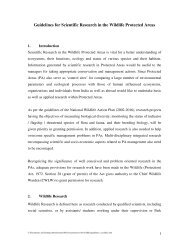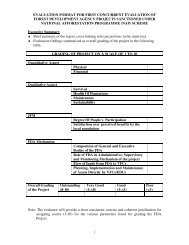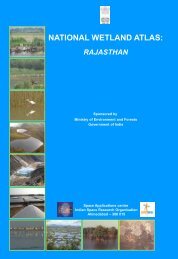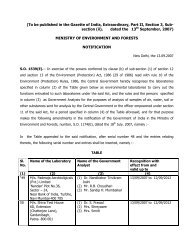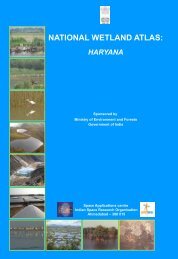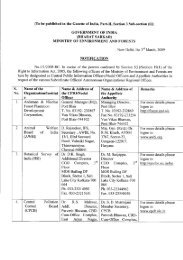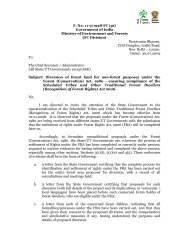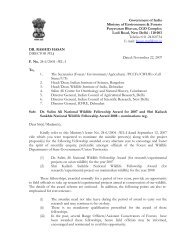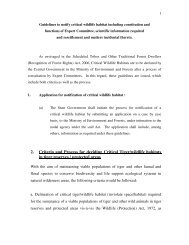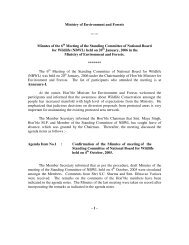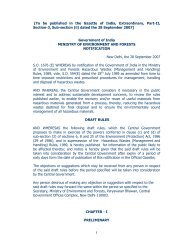national wetland atlas assam - Ministry of Environment and Forests
national wetland atlas assam - Ministry of Environment and Forests
national wetland atlas assam - Ministry of Environment and Forests
Create successful ePaper yourself
Turn your PDF publications into a flip-book with our unique Google optimized e-Paper software.
Annexure I<br />
Definitions <strong>of</strong> <strong>wetl<strong>and</strong></strong> categories used in the project<br />
For ease <strong>of</strong> underst<strong>and</strong>ing, definitions <strong>of</strong> <strong>wetl<strong>and</strong></strong> categories <strong>and</strong> their typical appearance on satellite imagery is given<br />
below:<br />
Wetl<strong>and</strong><br />
Definition <strong>and</strong> description<br />
type code<br />
1000 Inl<strong>and</strong> Wetl<strong>and</strong>s<br />
1100 Natural<br />
1101 Lakes: Larger bodies <strong>of</strong> st<strong>and</strong>ing water occupying distinct basins (Reid et al, 1976). These <strong>wetl<strong>and</strong></strong>s<br />
occur in natural depressions <strong>and</strong> normally fed by streams/rivers. On satellite images lakes appear in<br />
different hues <strong>of</strong> blue interspersed with pink (aquatic vegetation), isl<strong>and</strong>s (white if unvegetated, red in<br />
case <strong>of</strong> terrestrial vegetation). Vegetation if scattered make texture rough.<br />
1102 Ox-bow lakes/ Cut <strong>of</strong>f me<strong>and</strong>ers: A me<strong>and</strong>ering stream may erode the outside shores <strong>of</strong> its broad<br />
bends, <strong>and</strong> in time the loops may become cut-<strong>of</strong>f, leaving basins. The resulting shallow crescentshaped<br />
lakes are called oxbow lakes (Reid et al, 1976). On the satellite image Ox-bow lakes occur<br />
near the rivers in plain areas. Some part <strong>of</strong> the lake normally has aquatic vegetation (red/pink in<br />
colour) during pre-monsoon season.<br />
1103 High Altitude lakes: These lakes occur in the Himalayan region. L<strong>and</strong>scapes around high lakes are<br />
characterized by hilly topography. Otherwise they resemble lakes in the plain areas. For keeping<br />
uniformity in the delineation <strong>of</strong> these lakes contour line <strong>of</strong> 3000 m above msl will be taken as<br />
reference <strong>and</strong> all lakes above this contour line will be classified as high altitude lakes.<br />
1104 Riverine Wetl<strong>and</strong>s: Along the major rivers, especially in plains water accumulates leading to<br />
formation <strong>of</strong> marshes <strong>and</strong> swamp. Swamps are ‘Wetl<strong>and</strong> dominated by trees or shrubs’ (U.S.<br />
Definition). In Europe, a forested fen (a peat accumulating <strong>wetl<strong>and</strong></strong> that has no significant inflows or<br />
outflows <strong>and</strong> supports acidophilic mosses, particularly Sphagnum) could be called a swamp. In some<br />
areas reed grass - dominated <strong>wetl<strong>and</strong></strong>s are also called swamps). (Mitsch <strong>and</strong> Gosselink, 1986).<br />
Marsh: A frequently or continually inundated <strong>wetl<strong>and</strong></strong> characterised by emergent herbaceous<br />
vegetation adapted to saturated soil conditions. In European terminology a marsh has a mineral soil<br />
substrate <strong>and</strong> does not accumulate peat (Mitsch <strong>and</strong> Gosselink, 1986). Tone is grey blue <strong>and</strong> texture<br />
is smooth.<br />
Comment: Using satellite data it is difficult to differentiate between swamp <strong>and</strong> marsh. Hence, both<br />
have been clubbed together.<br />
1105 Waterlogged: Said <strong>of</strong> an area in which water st<strong>and</strong>s near, at, or above the l<strong>and</strong> surface, so that the<br />
roots <strong>of</strong> all plants except hydrophytes are drowned <strong>and</strong> the plants die (Margarate et al, 1974). Floods<br />
or unlined canal seepage <strong>and</strong> other irrigation network may cause waterlogging. Spectrally, during the<br />
period when surface water exists, waterlogged areas appear more or less similar to lakes/ponds.<br />
However, during dry season large or all parts <strong>of</strong> such areas dry up <strong>and</strong> give the appearance <strong>of</strong><br />
mud/salt flats (grey bluish).<br />
1106 River/stream: Rivers are linear water features <strong>of</strong> the l<strong>and</strong>scape. Rivers that are wider than the<br />
mapping unit will be mapped as polygons. Its importance arises from the fact that many stretches <strong>of</strong><br />
the rivers in Indo-Gangetic Plains <strong>and</strong> peninsular India are declared important <strong>national</strong> <strong>and</strong><br />
inter<strong>national</strong> <strong>wetl<strong>and</strong></strong>s (Ex. The river Ganga between Brajghat <strong>and</strong> Garh Mukteshwar, is a Ramsar site,<br />
Ranganthattu on the Cavery river is a bird sanctuary etc.). Wherever, rivers are wide <strong>and</strong> features like<br />
s<strong>and</strong> bars etc. are visible, they will be mapped.<br />
1200 Man-made<br />
1201<br />
Reservoir: A pond or lake built for the storage <strong>of</strong> water, usually by the construction <strong>of</strong> a dam across a<br />
river (Margarate et al, 1974). On RS images, reservoirs have irregular boundary behind a prominent<br />
dyke. Wetl<strong>and</strong> boundary in case <strong>of</strong> reservoir incorporates water, aquatic vegetation <strong>and</strong> footprint <strong>of</strong><br />
water as well. In the accompanying images aquatic vegetation in the reservoir is seen in bright pink<br />
tone. Tone is dark blue in deep reservoirs while it is ink blue in case <strong>of</strong> shallow reservoirs or reservoirs<br />
with high silt load. These will be annotated as Reservoirs/Dam.<br />
Barrage: Dykes are constructed in the plain areas over rivers for creating Irrigation/water facilities.<br />
Such water storage areas develop into <strong>wetl<strong>and</strong></strong>s (Harike Barrage on Satluj – a Ramsar site, Okhla<br />
barrage on the Yamuna etc. – a bird sanctuary). Water appears in dark blue tone with a smooth<br />
texture. Aquatic vegetation appears in pink colour, which is scattered, or contiguous depending on the<br />
density. Reservoirs formed by barrages will be annotated as reservoir/barrage.<br />
171


